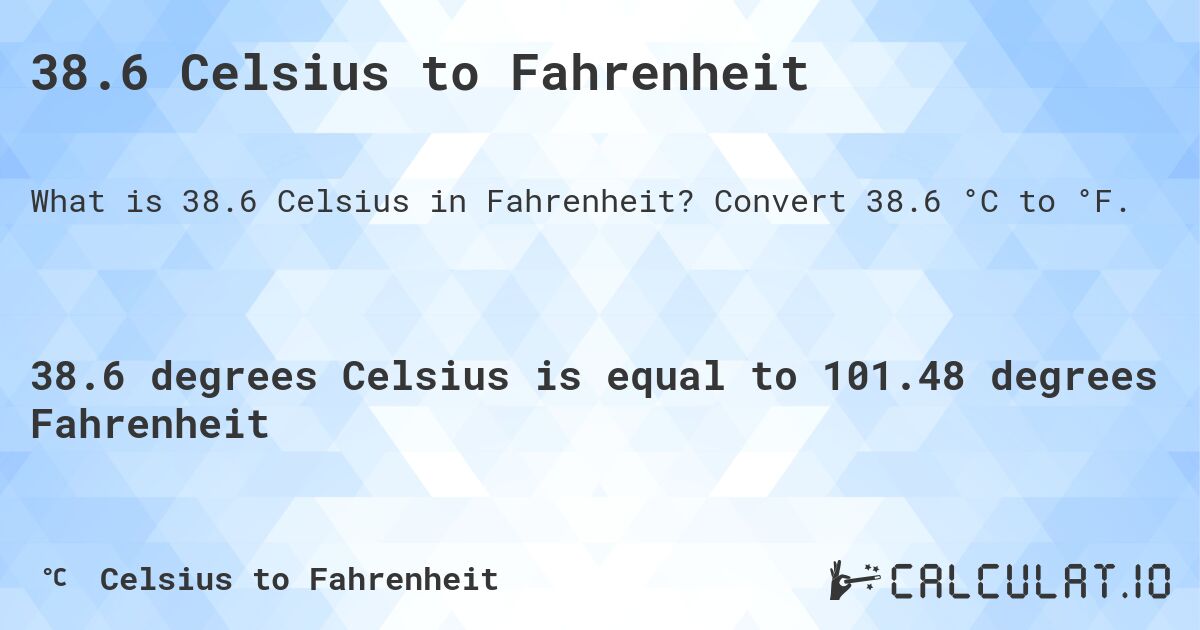Understanding Temperature Conversion: 38.6 Celsius To Fahrenheit

Converting temperatures can often be a confusing task, especially when dealing with different measurement systems like Celsius and Fahrenheit. One common conversion people might encounter is 38.6 degrees Celsius to Fahrenheit. This temperature is particularly relevant in discussions about fever and health, as it exceeds the normal body temperature range. In this article, we will explore how to accurately convert Celsius to Fahrenheit, the significance of 38.6 degrees Celsius in medical contexts, and provide some additional insights on temperature scales.
Temperature conversions play a crucial role in various fields, including meteorology, cooking, and healthcare. Understanding how to convert between these two systems can enhance our understanding of temperature-related discussions. Whether you're a student, a healthcare professional, or someone simply looking to understand more about temperature, this article will provide you with the necessary information and tools.
To begin, we will provide a clear explanation of the formula used to convert Celsius to Fahrenheit. Following that, we will delve into the implications of a body temperature reading of 38.6 degrees Celsius, its correlation with fever, and what it means for individual health. Lastly, we’ll touch on the broader context of temperature measurement and why these conversions matter in everyday life.
Table of Contents
The Conversion Formula: Celsius to Fahrenheit
To convert Celsius to Fahrenheit, you can use the following formula:
F = (C × 9/5) + 32
Where:
- F = temperature in degrees Fahrenheit
- C = temperature in degrees Celsius
This formula allows you to easily switch between the two temperature scales and is essential for anyone needing to understand temperature in both formats.
Example Conversion: 38.6 Celsius to Fahrenheit
Using the conversion formula, let’s calculate 38.6 degrees Celsius in Fahrenheit:
F = (38.6 × 9/5) + 32
F = (69.48) + 32
F = 101.48
Therefore, 38.6 degrees Celsius is equivalent to approximately 101.5 degrees Fahrenheit.
Why is This Important?
A body temperature of 38.6 degrees Celsius (or 101.5 degrees Fahrenheit) is often an indicator of a fever, which can signal an underlying health issue. Understanding this conversion can be crucial for assessing health conditions accurately, particularly in medical settings.
The Significance of 38.6 Celsius in Medical Contexts
In medical terminology, a fever is generally defined as a temporary increase in body temperature, often due to an illness. A normal body temperature typically ranges around 36.1°C to 37.2°C (97°F to 99°F). When body temperature rises above this range, it may indicate an infection or other medical conditions.
Specifically, a temperature of 38.6°C can be associated with:
- Viral infections (e.g., influenza, COVID-19)
- Bacterial infections (e.g., strep throat, pneumonia)
- Heat exhaustion or dehydration
It’s essential to monitor fever symptoms closely, especially in vulnerable populations such as children and the elderly.
Understanding Normal Body Temperature
Normal body temperature can vary based on several factors, including the time of day, the individual’s age, and activity level. Here’s a general breakdown:
- Normal range: 36.1°C to 37.2°C (97°F to 99°F)
- Low-grade fever: 37.3°C to 38.2°C (99°F to 100.4°F)
- Fever: 38.3°C and above (100.5°F and above)
Understanding these ranges can help individuals assess their health more effectively and determine when to seek medical attention.
Temperature Measurement: Celsius vs. Fahrenheit
Celsius and Fahrenheit are two widely used temperature scales, each with its own unique applications. Here’s a comparison of the two:
- Celsius: Widely used in most parts of the world for everyday temperature measurement.
- Fahrenheit: Primarily used in the United States for weather forecasts and some medical contexts.
The choice of scale often depends on geographical and cultural factors, and understanding both scales is essential for effective communication about temperature.
Common Misconceptions about Temperature Scales
There are several misconceptions surrounding Celsius and Fahrenheit that can lead to confusion:
- Some people believe that 0°C is the same as freezing in Fahrenheit; however, 32°F is the freezing point.
- The perception of temperature can vary; for instance, 100°F feels much hotter than 38°C, even though they represent similar conditions.
Understanding these misconceptions can help clarify temperature discussions and prevent misunderstandings.
Practical Applications of Temperature Conversion
Temperature conversion is not just a theoretical exercise; it has several practical applications, including:
- Cooking: Recipes may use different temperature scales.
- Healthcare: Monitoring body temperature during illness.
- Travel: Understanding local weather conditions.
Being able to convert temperatures accurately can enhance personal safety and well-being, especially in health-related scenarios.
Conclusion
In conclusion, converting 38.6 degrees Celsius to Fahrenheit yields approximately 101.5 degrees Fahrenheit. Understanding this conversion is essential, particularly in medical contexts, as it helps identify fever and associated health issues. We encourage readers to be mindful of their body temperature and seek medical advice when necessary. If you found this article informative, please leave a comment below or share it with others who may benefit from this knowledge.
We hope this article has provided you with valuable insights into temperature conversion and its significance. Don’t hesitate to explore more articles on our site to enhance your understanding of related topics!
ncG1vNJzZmivmaC2b7XSrJirrZKWe6S7zGikmrCemsS0g45sb29lk5q5tLXUrGStp12brqm%2BxKefnqGkY7W1ucs%3D